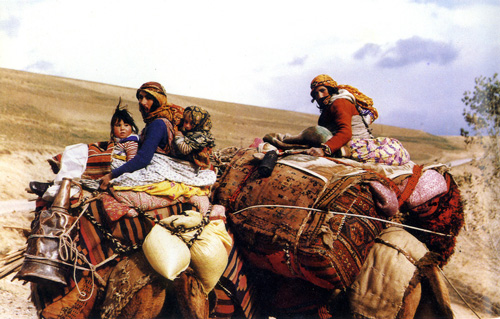Your wish list is empty.
Oriental Rugs » Rug Types
Distinguishing Tribal, Village and Classical rugs.
Submitted by Carolien van Straten, Co-Manager, The Magic Carpet

Kurd weavers moving to summer pastures.
The Oriental rug world is filled with amazing designs and variations, but when we look at Oriental rugs, we can usually distinguish at least three different main types: geometric designs, floral/curvilinear ones, as well a combination of both.
The style of a rug reflects the environment and circumstances in which it was made. As a very general categorization, one can say that there are three broad stylistic groups. These are the tribal, village and city rugs. Each category employs specific techniques, materials and styles, unique to its own culture. Tribal carpets are usually woven with simple, bold designs, using geometric forms and a warm color palette. Village rugs tend to have more elaborate geometric/floral designs, while city rugs are typically the most floral, with intricate designs.
Tribal nomadic groups have always produced rugs as a fundamental activity of their culture. They were made for their own practical use, including for dowries, weddings and ceremonies. The rugs would be woven on the ground, with horizontal looms that were easily taken apart, portable and generally not too large, which typically made for smaller rugs. In this tradition, the designs were passed down from generation to generation, mother to daughter. The weaver would take these traditional tribal designs, but often add their own creative genius to make an art form that is not only captivating but also highly desirable and collectable.
Few tribal rugs are made today, but these designs have been kept alive by cultural survival projects in Afghanistan, India, Nepal and Pakistan. They are using hand carded and hand spun wool, with vegetable dyes and are reinvigorating the now settled cultures with the pride of producing some of the finest tribal design rugs on the market. Many examples of these rugs can be seen at the Magic Carpet.
In village rugs, we often find a combination of both geometric and floral designs. Most of these rugs are woven either in the villager’s homes or sometimes in workshops, which allows the weavers to employ much larger, vertical looms. Although some of these rugs were made for personal use, many of them were produced in order to be sold. These rugs oftentimes would not have the whimsical, spontaneous character of the tribal rugs, as they were often woven from pre-set rug cartoons, yet there are many incredibly beautiful rugs from this tradition as well.
The city workshops produce what we know as the more classical Oriental rugs. Their purpose is solely for commercial use, often for markets overseas. What sets these apart from the other two types of rugs, is that they are mostly woven using high knotted, complex curvilinear designs. In this tradition, a designer creates the cartoons, which the weaver then translates into intricate, floral rugs. Often times these rugs are woven with fifteen to twenty different colors and take far longer to weave.
A rug lover’s preference is a very personal one. Some enjoy the simplicity and boldness of a tribal rug. Others like the more floral, classical rug, and many look for a combination of the two. The variety in Oriental rugs is enormous and an endless source of study and discovery. We welcome you to come and see examples of all different types at The Magic Carpet or view our collection online.
The Magic Carpet will be offering monthly educational articles on the extraordinary art and history embodied by Oriental rugs. In our next article we will be examining how we appraise Oriental rugs.
For any questions about Oriental rugs, please contact us at 530-265 9229 or at . We are located at 408 Broad Street(The New York Hotel) in Nevada City.


